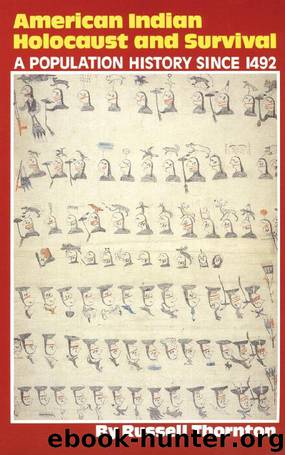American Indian Holocaust and Survival A Population History Since 1492 by Russell Thornton

Author:Russell Thornton [Thornton, Russell]
Language: eng
Format: epub
Published: 2011-01-18T01:09:37+00:00
Date Size
1890 248,253 1900 237,196 1910 276,927 1920 244,437 1930 343,352 1940 345,252 1950 357,499 1960 523,591 1970 792,730 1980 1,366,676
(%)
-4.5
16.8 -11.7 40.5 0.6 3.5 46.5 51.4 72.4
Size
62,947,714 75,994,575 91,972,266 105,710,620 122,775,046 131,669,275 151,325,798 179,323,175 203,302,031 226,545,805
Decade (%)
20.7 21.0 14.9 16.1 7.2 14.5 18.5 13.4 11.4
1982-83: 6, 1984:14),
American Indian
Change from Previous Decade
Total United States Change from Previous
Page 160
SOURCES: U.S. Bureau of the Census (1915:10, 1973a:xi, Swagerty and Thornton (1982:92).
the American Indian population grew about 281 percent, while the total United States population grew only about 48 percent. In 1950 the percentage of the total United States population that was American Indian was only 0.2 percent, basically unchanged since 1890. It increased to 0.3 percent in 1960, about 0.4 percent in 1970, and 0.6 percent in 1980. In 1987 it is perhaps about 0.7 percent.
American Indian Population by State
The census data for the 50 states and the District of Columbia show that the population recovery has not been uniform. Since the turn of the century the American Indian population of some states has increased more than that of other states, as shown in table 72. Of importance here, in addition to a natural increase within states, has been a migration of American Indians between states. California, for example, gained many American Indians by migration; one-half of the 200,000 American Indians in California in 1980 were immigrants from other states (Heizer and Elsasser, 1980 : 225). Large numbers of American Indians have recently moved to California, as have large numbers of non-Indians, and these immigrants have further increased the state's Indian population through natural increases.
In 1987 there were wide variations in the numbers of American Indians from state to state just as there were wide variations in the numbers of non-Indians. Table 72 shows that in 1980, California had the largest American Indian population, 198,275, and Vermont had the smallest, 968. According to the 1980 census, California also had the largest total population, 23,667,837, while Alaska had the smallest total population, 401,851.2
2. One may wish to see Prucha (1985) for a map showing variations in the American Indian populations both between and within states.
< previous page page_160 next page >
file:///C:/Users/User/AppData/Local/Temp/Rar$EX00.794/080612220X/files/page_160.html[1/17/2011 5:11:08 PM]
page_161
< previous page page_161 next page >
American Indian Population by Tribal Groups
The recovery of the American Indian population has not been uniform among American Indian tribal groups. Some groups have gained population far more rapidly and to a much greater extent than others; some groups have even declined in population during the twentieth century. According to U.S. censuses, the Navajo had tremendous population growth between 1910 and 1980, from 22,455 to 158,633 (they are now far more numerous than in 1492), as did the Sioux, who increased from 22,778 to 78,588, and the Ojibwe, who increased from 20,214 to 73,491.
Other population patterns are also evident, particularly among smaller tribes. In the Northwest and northern California the populations of some smaller tribes have increased significantly (for example, that of the Tolowa, from less than 150 to about 400); others have increased very
Download
This site does not store any files on its server. We only index and link to content provided by other sites. Please contact the content providers to delete copyright contents if any and email us, we'll remove relevant links or contents immediately.
| African-American Studies | Asian American Studies |
| Disabled | Ethnic Studies |
| Hispanic American Studies | LGBT |
| Minority Studies | Native American Studies |
Cecilia; Or, Memoirs of an Heiress — Volume 1 by Fanny Burney(32434)
Cecilia; Or, Memoirs of an Heiress — Volume 2 by Fanny Burney(31871)
Cecilia; Or, Memoirs of an Heiress — Volume 3 by Fanny Burney(31854)
The Great Music City by Andrea Baker(31349)
We're Going to Need More Wine by Gabrielle Union(18967)
All the Missing Girls by Megan Miranda(15570)
Pimp by Iceberg Slim(14393)
Bombshells: Glamour Girls of a Lifetime by Sullivan Steve(13972)
Talking to Strangers by Malcolm Gladwell(13222)
Norse Mythology by Gaiman Neil(13204)
Fifty Shades Freed by E L James(13157)
For the Love of Europe by Rick Steves(12983)
Mindhunter: Inside the FBI's Elite Serial Crime Unit by John E. Douglas & Mark Olshaker(9200)
Crazy Rich Asians by Kevin Kwan(9167)
The Lost Art of Listening by Michael P. Nichols(7406)
Enlightenment Now: The Case for Reason, Science, Humanism, and Progress by Steven Pinker(7231)
The Four Agreements by Don Miguel Ruiz(6630)
Bad Blood by John Carreyrou(6552)
Weapons of Math Destruction by Cathy O'Neil(6143)
